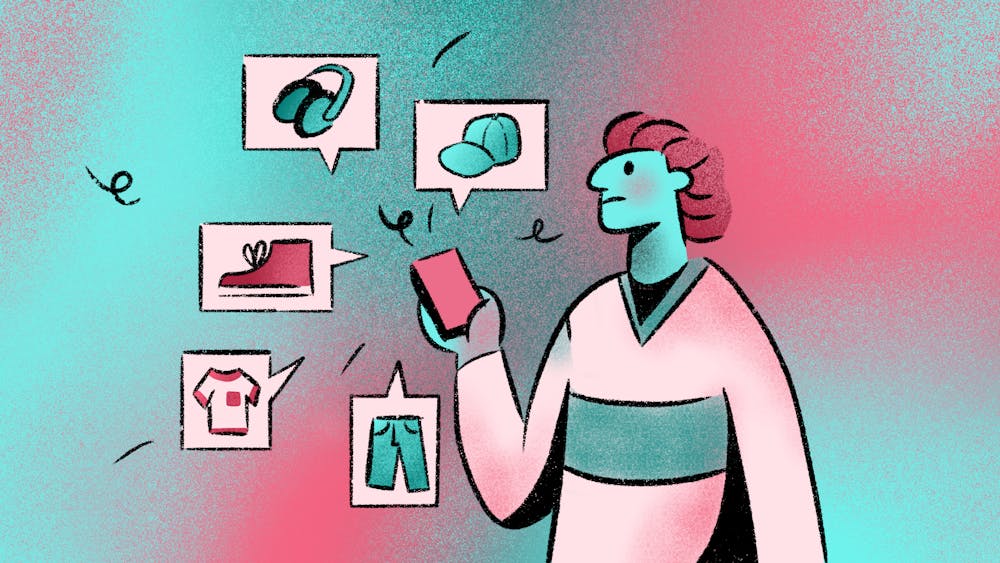For as long as I can remember, I’ve loved advertisements. As a young child growing up in Pakistan, my eyes would be glued to television commercials of beautiful women in extravagant wedding clothes and the clever billboards on the highway of greasy Kentucky Fried Chicken. Whenever my family traveled abroad and I had access to all the Teen Vogue and Seventeen magazines I could dream of, I spent hours flipping through the vibrant glossy pictures, captivated by the creativity before my eyes.
Before moving to the United States, I had never experienced the thrill of online shopping that comes with a hyper–consumerist society. Foreign brands rarely ship to Pakistan (even though most of them manufacture their supply there, but that’s a topic for another day), and so, I spent my high school years ogling over pictures of delicately–knitted sweaters and chic leather boots. At home, online shopping was a three–month–long process. If I wanted to make a purchase, I would ship it to my aunt in London first. I could only hold my coveted package in my hands months later, when a traveling family member with a layover in London picked it up for me. As much as I hate to admit it, it often wasn’t worth the hassle. Yet, living in the U.S., I feel a new kind of retail power. After years of waiting ages for my packages to arrive, I can now buy anything, from MUJI pens on Amazon to a pair of Lululemon leggings, with the push of a button. As time passed, it became difficult to stop this vicious consumerist cycle.
We’ve long been taught that we need to own objects in order to be happy. Hyper–consumerism is capitalism’s best friend, pushing us to spend money to drown out our stresses and sadness with dopamine rushes. In a 2012 Vox interview, psychologist Juliet Schor dates hyper–consumerism back to the development of mass production in the 1920s. Consumers have long felt a need to buy more and more, even if they don’t need it. According to Schor, a major driver of this excessive consumption is comparison. Schor’s concept of “competitive consumption” describes the idea that everyone belongs to a specific social group in society and feels pressured to buy to identify with their surroundings.
A new era of obsession with retail and competitive consumption began on 2010s YouTube. Creators, deemed “beauty gurus” by subscribers, uploaded makeup collection videos, boasting of their arrays of Urban Decay Naked palettes and MAC lipsticks. Their audiences wished to fill their drawers with the same products. Jordan Theresa says it best in her video essay, “When something is put in your face enough, you either want it or your brain will think that you need it and that it’ll make you happy.” Yet, as most of us have witnessed, this happiness is usually temporary. Shortly, the desire to make another purchase for another hit of happiness creeps back.
In our online world, monetization and hyper–consumerism are only growing more extreme. Instagram and TikTok have established features that allow users to buy products promoted on the platforms in seconds. Brands pay influencers to convince us to purchase things like powders that replace eating vegetables and skincare mini fridges. In January, a Bloomberg article revealed that TikTok plans to introduce a new feature that would allow users to shop any post by suggesting similar items on TikTok Shop. Additionally, the platform hopes to open live–streaming studios in major U.S. cities to encourage creators to pitch items to their followers. These studios, equipped with professional lighting and cameras, will provide "a boost for making the Home Shopping Network–like videos.”
From no–skip ads before most YouTube videos to “#ad” hidden at the bottom of long captions raving about “life–changing” products, users are constantly being sold something. It has become increasingly more difficult to navigate the online space without feeling pressure to spend. By making online purchases, we can feel the instant gratification of a massive dopamine rush. When the rush wears off, we have accumulated hordes of loungewear sets and useless gadgets to collect dust in our closets.
Hyper–consumerism is the root of microtrends, the products we “have to have” and forget about three months later. It drives lines of customers to their nearest Targets to get their hands on the limited edition Starbucks Stanley Cup. Our identities have grown attached to our belongings. In his essay “Are We This Far Gone?” Frederick Joseph labeled this phenomenon as a “commodification of identity.” We are always in pursuit of wanting and buying what everyone else has, compromising our individualism to fit in with the crowd. With online shopping addictions only continuing to grow, what will happen if we continue to measure our self–worth and identity by whether we can keep up with trends?
Many are becoming aware of the dangers of excessive monetization. Social media creators have begun sharing "de–influencing" videos, convincing their audiences to opt out of trendy items. Earlier this month, TikTok user @casuallykatiee posted a video sharing the products she will not be convinced to purchase in 2024. She attempts to de–influence users from purchasing single–use face towels, multiple lip glosses of the same shade, and the viral Hatch alarm clock. Slowly but surely, we’re shifting our attention from buying for the sake of it to increased consciousness.
It is crucial to resist being bought by our favorite brands. By focusing on the value of our belongings instead of being preoccupied with owning new ones, we can take baby steps away from our hyper–consumerist tendencies. The satisfaction of shopping can only fill our carts for so long.

